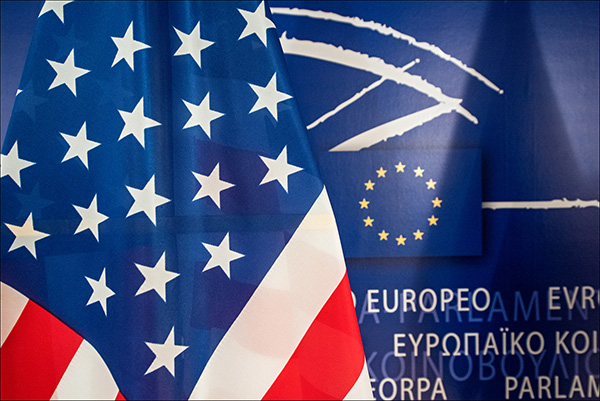
The political and geopolitical convergence between the new Biden Administration and the EU and its member states is starting to become evident. But economic divergence may be emerging at the same time, with the US pulling ahead, as a result of the manner of tackling recovery from the COVID-19 crisis. We are witnessing a clash of economic paradigms that could lead to serious transatlantic disruption in a range of areas.
The political and geopolitical convergence includes the US return to a degree of multilateralism (the partial unblocking of the World Trade Organisation –WTO– and the return to the World Health Organisation –WHO–), the cultivation of allies and partners (in NATO and by reviving the QUAD group with Australia, South Korea, India and Japan), and the defusing, at least temporarily, of certain trade disputes with the EU. As Luis Simón rightly points out, however, everything that comes out of Washington is geared towards gaining support for its policy on China, for which it has not yet fully won over the European side, barring some minor gestures such as sanctions against individuals and some companies; retaliatory measures were announced by Beijing, with the Chinese public being stirred up against some Western brands that had criticised certain regime policies. US policy towards China tends to aim at encircling it geopolitically, although it no longer aims solely at halting its economic development but also at accelerating the US economy much faster. And the EU is being left behind.
The stimulus announced by the Biden Administration amounts to US$1.9 trillion, which is in addition to the trillion dollars pumped in by the Trump Administration. To a significant extent (accounting for around 20%) this comprises direct aid to individuals (the so-called helicopter money) of US$1,400 for people who earn less than US$75,000 per annum, or households that earn less than twice that (the Trump Administration had already given US$600 to more adults). The US stimulus, according to some calculations, is more than twice the size of its EU counterpart (which is considerable, at around 6% of GDP, using European and national funds, although the EU is ahead in terms of providing liquidity to companies). The Biden Administration hopes these measures will not only revive consumption but also have a direct impact on reducing inequality, additionally made viable by a sub-3% unemployment rate that will push wages up.
Biden has proposed a supplementary package of US$2.25 trillion (1% of GDP over the next eight years) to invest in infrastructure –an area where the US has fallen well behind the EU–, transport, clean energy, connectivity and technology in order to create jobs and try to ensure lasting superiority in this area over China, something that is by no means assured. Developments are unfolding very fast, often unaccompanied by immediate dividends for company shareholders (frequently the state). This new ‘Biden package’ will be financed not only by more debt and a larger deficit (where the dollar’s hegemony helps) but also by more corporate taxes, in which there may be convergence with the EU’s agenda.
The 2000 Lisbon strategy sought to turn the EU into the world’s most competitive economy by 2010. It failed in both method and means. Now the EU, immersed in a fever of strategies –but not yet an entrepreneurial fever– seeks to regain the ground lost over recent decades. The current EU plan is geared towards not only restoring but also transforming the economy and steering it in a more digital and greener direction. But it is insufficient for what is at stake on the worldwide stage. An example is provided by the Digital Compass unveiled by the European Commission. Among other aspirations it suggests that by 2030 Europe should supply 20% of worldwide demand for semiconductors as well as having its own quantum super-computer. But where is the investment? Where are the plans for this? And where is the EU soul-searching about the fact that just a few years ago it was a leader in mobile phones and other consumer electronics industries but is now no longer? As Giles Merrit points out, the new semiconductor ‘foundry’ opened by Infineon, Europe’s largest chip producer, in Villach, Austria, will cost less than a tenth of the enormous TSMC plant, at US$20 billion, in the south of Taiwan. TSMC is now the largest chipmaker, and Taiwan has grown in strategic importance as a consequence. For its part, Intel is set to invest a similar amount in two new chip foundries in Arizona to double its capacity. Even when it manufactures abroad, the US retains control over the design of the most advanced semiconductors.
The US is vaccinating its population more quickly than the EU, which influences the health of the economy, but the differing stimulus packages also help to determine the different recovery speeds. The EU has opted for the German system of employment (involving furloughs in Spain) and restricted or partial benefits to prevent mass lay-offs, but it has limits. The US, by contrast, prefers direct aid. The OECD calculates not only that the US economy is set to grow by 6.5% in 2021, compared with 3.9% in the Eurozone (although if there is no new pandemic-induced recession in 2022 they will be more comparable) but also that the US stimulus will add one percentage point to worldwide growth. By the end of the year the US economy will be one point ahead of pre-COVID forecasts, and by 2022, according to projections, will have grown by 6% relative to pre-COVID times, whereas the EU’s economy will be the same as prior to the pandemic. This is more than resilience. That said, EU exports to Asia, including China, have remained steady.
The EU does not need unrealistic targets but rather specific plans and projects, such as Airbus was and remains to this day. It is encouraging that for the first time the EU has reacted with federal fiscal policies, and with clear strategic outlines, but it has fallen short. Some, such as Macron, are becoming increasingly concerned by this divergence and starting to propose that the EU and its member states increase their stimulus packages significantly. This will not prove easy, given the resistance to more spending from the EU itself (it remains to be seen what the German Constitutional Court will rule, something that may take months); nor do the European economies, Spain being a case in point, have the capacity to absorb much more in the way of funds. They are less flexible than the US and even the Chinese economy. The French President wants ‘to invest faster and stronger in our priorities’ and calls on the Union ‘to drastically simplify’ its stimulus plan. ‘We are too slow, we are too complex, we are too entangled in our own bureaucracies’, he says, although what others demand is precisely more control to avoid squandering public EU money.
Amid divergence such as this the EU lacks sufficient dynamism and runs the risk of becoming more dependent on the US and China, when what it seeks is greater autonomy and even ‘sovereignty’. China, partly owing to the effects of the pandemic, has overtaken the US as the EU’s largest trading partner in goods, according to Eurostat figures. Brussels has proposed a joint Transatlantic Agenda and an EU-US Green Tech Alliance. Is this viable if there is divergence and when the main technologies reside in US and Chinese hands?


